Abstract
The paper studies the matter related to the use of an interactive computer simulator in Mathematics course when using blended learning technology in the current university education. As an example, the authors describe the original computer software Integral Test 1.0, designed to practice the antiderivative skills and academic performance rating when studying the topic Function Integration of one real variable. A special feature of this software, which distinguishes it from standard diagnostic programs favourably, is that a student is not asked to choose the correct answer from several suggested options. He needs to enter the answer on his own in the field intended for this purpose. The antiderivative is typed from the keyboard as a string according to the customary rules, and the software visualizes the answer in the traditional form and verifies it. Using such a simulator allows one to actualize a component of the interactive mode of blended learning technology. Students have an opportunity to work out their computing skills without a teacher’s supervision. The authors present the results of an experiment that was conducted among first-year students majored in Engineering for two years. The experiment confirmed the effectiveness of using an interactive computer simulator in blended mathematics study. In particular, the quality of academic performance in the experimental group increased by 8.7%.
Keywords: Interactive computer program, massive open online courses, traditional learning, distance learning, blended learning, Moodle system
Introduction
The quick development of IT is a characteristic component of the present-day reality. Technological progress has involved education as well. The use of the latest technical innovations in designing electronic educational platforms allows one to arrange high-quality online education and allows for new opportunities in teaching Mathematics. Modern technologies also have a significant impact on the way mathematics is taught. For example, specialized software is being introduced into education (Eyrikh et al., 2018) and hand-on computer games (Eyrikh et al., 2019).
Nowadays, blended learning is becoming more and more popular in the higher education system. This is a form of education in which training is conducted both in the traditional full-time form and distance learning. It implies the interaction of a teacher and students at a distant way and reflects all the components special for education and is conducted through Internet technologies or other means that provide interactivity (Deza, 2016). Russian and foreign authors present many scientific publications and hands-on applications that address various aspects of using blended, distance, electronic, and online learning (Aziatzeva, 2016; Bekisheva, 2016; Borba et al., 2016; Gecer & Dag, 2012; Kashefi et al., 2012; Pokorný, 2019). These types of learning involve the use of various e-learning courses.
Massive open online courses (MOOCs) have been used in educational practice of foreign universities for a long time. Such learning technology becomes an integral part of studying, thereby producing new conditions for training opportunities.
In Russian universities, this practice began to be introduced more recently. However, as recent events show, there are situations when such courses are extremely necessary. The introduction of MOOCs in university education is a natural consequence of modern development trends (Krasnov et al., 2019). The paper (Semenova & Vilkova, 2017) differentiates three main types of inclusion of online courses in curricula. One of them is MOOC incorporating into a blended learning format.
The most popular of educational platforms is Moodle distance learning system. It is widely used by many state and private educational institutions around the world and brings in new learning perspectives.
Problem Statement
Integral calculus is one of the most difficult sections of Mathematics course. To learn how to calculate integrals one needs to solve a fairly large number of them. After all, it is only in training one can learn to do calculations and understand what type of integrals this or that one, and what method of solution can be applied. There are no universal training programs for integrating learning. There are some developments on separate integration methods or integration of certain types of functions. For example, in the paper (Popov, 2010), the author describes a simulator designed for finding integrals of fractional-irrational functions, in which a solution is generated with all intermediate actions and the correctness of each entered symbol is checked when reducing the integral to an antiderivative. The study by (Yarikov, 2011) presents a simulator for finding the integral of the product of functions by the integration technique in parts.
Research Questions
This research is related to the use of some properties of distance learning technologies within taking an electronic training course in Mathematics, in particular the topic Integral Calculus. The authors assume that designing e-course is based on Moodle capabilities, and its implementation in a blended learning environment is based on the traditional classroom learning process.
A computer cannot replace a teacher, but in fact, it can partially make his work easier- it is true. For this reason, it is possible to substitute routine checking up standard examples by mastering computing skills in favour of computer software.
For this purpose, the authors use the Integral Test 1.0 simulator designed in Embarcadero Delphi XE5 software environment in the learning process. Microsoft Office Access DBCS was used to design the database.
Purpose of the Study
The goal of the research is to study the effectiveness of using a computer simulator to practice the skills of antiderivation and testing students’ skills on the topic Integration in actualizing blended Mathematics studying at university.
Research Methods
The software Integral Test 1.0 has a simple and user-friendly interface that allows users of various proficiency levels to manage with it. The main window menu allows one to select the necessary operations and has the following sections: file, testing, help. After selecting the Testing menu item, the user will have access to the following menu items: mode, start, end, test history. When he points at the menu item Mode, two sub-items appear Training and Exam. Further testing directly depends on which mode is selected. When he clicks on the Start menu item, a data entry form appears, where one needs to enter the following items: last name and first name, major and group number of the test subject. After entering the data about the test subject, the task selection form (Figure 01) is filled in, where one can select the number of integrals of each type that the software will generate.
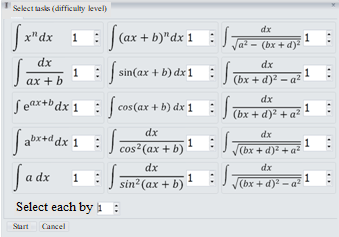
Next, the main form appears (Figure 02), which shows a list of randomly generated, numbered and mixed up tasks in a random manner on the left, and a countdown is displayed on the top right, after which the test is completed and the message time up appears. The rules for entering functions are shown at the bottom of the main form. The selected integral is visualized in a user-friendly way at the top in the centre of the form.
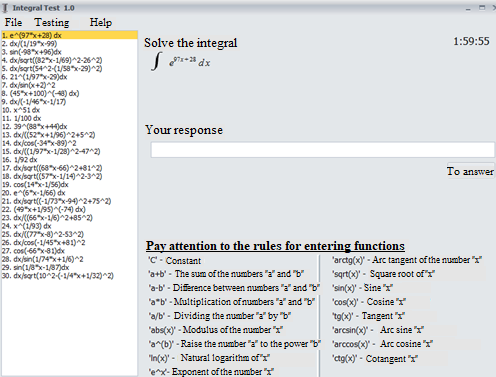
When one enters the answer in the Your answer field, the program visualizes the entered the antiderivative in a traditional form (Figure 03). One needs to press the Answer button or press the ENTER key for the program to accept the answer.

If the program runs in the Exam mode, the results of automatic verification of the entered answers are not immediately displayed to the test taker. The program only greys those tasks for which answers have already been entered. If the program is Training, a student can see the results of the automatic verification test at once: the correct answers are highlighted in green and incorrect answers are marked red (Figure 04).
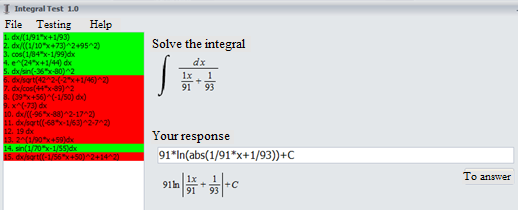
After testing is complete, in the main form, there is information about the results of the test: a name and a surname, a major and a group of a student, a selected test mode, the selected testing time, based on a five-point scale, the number and percentage of the completed tasks, the time spent, begin time and completion time of the test. It also provides the detailed testing: information about the generated integrals, generated responses, responses of the test subject, and verification of each response (Figure 05).
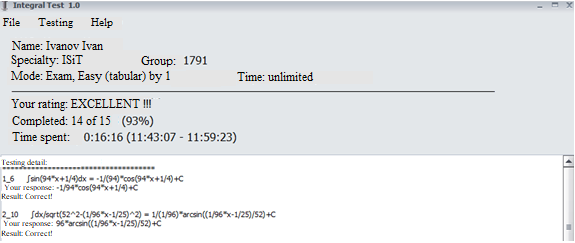
Findings
The computer simulator Integral Test 1.0 was used while studying the topic Integration in blended learning. The experiment was conducted at Sholom-Aleichem Priamursky State University, Pacific National University and the Far Eastern State Transport University in the 2018-2019 and 2019-2020 academic years. The first-year students’ training majored in Applied Mathematics and Electric Power and Electrical Engineering (a control group consisted of 63 people) took place without using a computer simulator. First-year students whose major is Information systems and Technologies and Construction (an experimental group involved 69 people) mastered their skills of finding antiderivatives using Integral Test 1.0.
Both groups were compared by the academic performance from the beginning. However, academic performance was considered based on the results of studying the topic of Function Differentiation. Qualitative performance in the control group was 44%, and 43.5% in the experimental group (Figure 06).
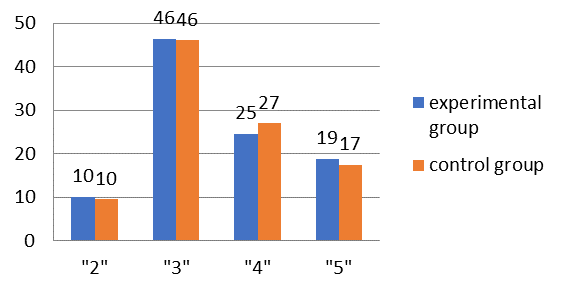
The students’ performance after studying the topic Integration is presented in Fig. 07. The quality of academic performance in the control group decreased slightly and equalled to 42.9%, and it increased and amounted to 52.2%.in the experimental group.
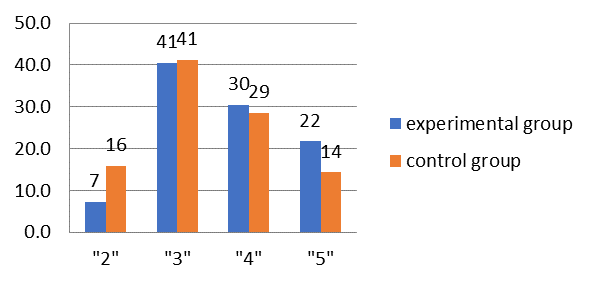
The results of the experiment confirmed the effectiveness of using a computer simulator for practising the skills of finding antiderivatives, and it contributed to the improving quality of the results obtained.
Conclusion
Finally, the conducted research allows the authors to conclude on the effectiveness of using the computer software Integral Test 1.0 for mastering calculating skills and to expect a similar effect from the similar interactive computer software. Moreover, computer-assisted blended learning based on the traditional classroom form of the learning process can partially make a teacher’s work easier. Besides, various computer training programs can be integrated into an electronic training course, which distinguishes it from other similar courses in an original way.
Acknowledgments
The authors’ thanks are extended to Nikita Tromsa, a graduate of Sholom-Aleichem Priamursky State University, the developer of.
References
Aziatzeva, T. V. (2016). Obzor sushhestvuyushhikh zа rubezhom kursov, sozdаnnykh s primeneniem tekhnologii smeshаnnogo obucheniya [The review of existing foreign courses that use the technology of blended learning]. Prepodavatel XXI vek, (2-1), 177-183. https://www.elibrary.ru/download/elibrary_26134884_73563821.pdf [in Russ.].
Bekisheva, T. G. (2016). Smeshаnnoe obuchenie: sovremennye tendentsii v vuzаkh [Blended learning: modern tendencies in higher education]. Modern Research of Social Problems, (11-2), 37-42. https://cyberleninka.ru/article/n/smeshannoe-obuchenie-sovremennye-tendentsii-v-vuzah/viewer [in Russ.].
Borba, M. C., Askar, P., Engelbrecht, J., Gadanidis, G., Llinares, S., & Aguilar, M. S. (2016). Blended learning, e-learning and mobile learning in mathematics education. ZDM Mathematics Education, 48, 589-610.
Deza, E. I. (2016). Osobennosti postroeniya mаtemаticheskikh kursov v usloviyakh smeshаnnogo obucheniya [Features of constructing mathematical courses in the conditions of blended learning]. Nauka i shkola, 6, 160-169. [in Russ.].
Eyrikh, N. V., Bazhenov, R. I., Markova, N. V., & Putkina, L. V. (2018). Applying Maple computing environment in teaching mathematics to university students majoring in technical. 2018 IEEE International Conference "Quality Management, Transport and Information Security, Information Technologies" (IT&QM&IS), 623-628. https://www.scopus.com/record/display.uri?eid=2-s2.0-85058062571&origin=resultslist&sort=plf-f&src=s&sid=659224e2ce9932a600602678d57c3446&sot=autdocs&sdt=autdocs&sl=18&s=AU-ID%2812142083100%29&relpos=0&citeCnt=0&searchTerm
Eyrikh, N., Fishman, B., Bazhenov R., Markova N. & Pitsuk I. (2019). Hands-on games for motivating students’ math training. Proceedings of the 2019 IEEE International Conference “Quality Management, Transport and Information Security, Information Technologies; IT and QM and IS 2019, art. no. 8928404, 477-481. https://www.scopus.com/record/display.uri?eid=2-s2.0-85077771461&origin=SingleRecordEmailAlert&dgcid=raven_sc_author_ru_ru_email&txGid=2e2834685600dd669742bf7f78c1cd15
Gecer, A., & Dag, F. (2012). A blended learning experience. Educational Sciences: Theory and Practice, 12(1), 438-442. https://files.eric.ed.gov/fulltext/EJ978452.pdf
Kashefi, H., Ismail, Z., Yusof, Y. M., & Rahman, R. A. (2012). Supporting students mathematical thinking in the learning of two-variable functions through blended learning. Procedia-Social and Behavioral Sciences, 46, 3689-3695.
Krasnov, S. V., Kalmykova, S. V., & Krasnov, A. S. (2019). Blended learning as a form of transition from traditional learning to digital learning. 2019 II International Conference on High Technology for Sustainable Development (HiTech), Sofia, Bulgaria, 1-4.
Pokorný, M. (2019). Blended learning can improve the results of students in combinatorics and data processing. 2019 International Symposium on Educational Technology (ISET), Hradec Kralove, Czech Republic, 207-210.
Popov, A. A. (2010). Trenazher po nahozhdeniyu pervoobraznoj funkcii dlya integrala s drobno-irracional'nym vyrazheniem [Simulator for finding a primitive function for an integral with fractional-irrational expression]. Vestnik of the Mari State University, 5, 297-300. [in Russ.].
Semenova, T. V., & Vilkova, K. A. (2017). Tipy integrаtsii mаssovykh otkrytykh onlаjn-kursov v uchebnyj protsess universitetov [Types MOOC integration into universities’ educational process]. Journal University Management: Practice and Analysis, 21(6) (112), 114-126. [in Russ.].
Yarikov, V. V. (2011). Trenazher po nakhozhdeniyu pervoobraznoj slozhnoj funktsii dlya integrala vida [Simulator for finding a primitive composite function for an integral of the form P(x)Q(x)]. Educational Technology & Society, 11(4), 368-376. [in Russ.].
Copyright information

This work is licensed under a Creative Commons Attribution-NonCommercial-NoDerivatives 4.0 International License.
About this article
Publication Date
21 June 2021
Article Doi
eBook ISBN
978-1-80296-110-2
Publisher
European Publisher
Volume
111
Print ISBN (optional)
-
Edition Number
1st Edition
Pages
1-1168
Subjects
Social sciences, education and psychology, technology and education, economics and law, interdisciplinary sciences
Cite this article as:
Eyrikh, N., Markova, N., & Matveeva, E. (2021). Interactive Computer Software As An Effective Tool For Blended Learning. In N. G. Bogachenko (Ed.), Amurcon 2020: International Scientific Conference, vol 111. European Proceedings of Social and Behavioural Sciences (pp. 272-278). European Publisher. https://doi.org/10.15405/epsbs.2021.06.03.37

